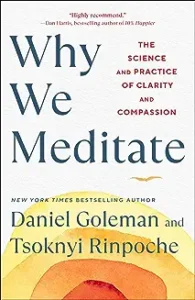Why We Meditate: The Science and Practice of Clarity and Compassion by Daniel Goleman and Tsoknyi Rinpoche 2022
I have been practicing mindfulness meditation somewhat regularly for the last nine years and have tried to inform my practice by reading a book by one of the leaders in that movement every few months. Works by Pema Chodron, Joseph Goldstein, Shunryu Suzuki, Tara Brach, Susan Salzberg, and Dan Harris have all contributed to my practice. While all of these writers sound the same themes—impermance, freedom from craving and grasping, bringing one’s attention to the breath as a way of becoming awake and aware of the present moment, not becoming immersed in ‘add ons’ that distort the narrative of our life, and emphasizing the importance of kindness, equanimity, compassion and living with joy—-each one has provided me with at least one big idea that I can carry away from their book, one key phrase or practice that will enhance my own mindfulness meditation practice.
Enter Tsoknyi Rinpoche and Daniel Goleman, the former a Buddhist meditation teacher and Tibetan monk and the latter a Pulitzer Prize nominated science writer who coined the term ’emotional intelligence.’ In alternating chapters, Rinpoche provides his own unique take on mindfulness meditation and Goleman provides the scientific basis for the physical, mental, and spiritual effects of meditation.
While much of Tsoknyi Rinpoche’s practice was familiar and consistent with my prior reading, I did find one new and very helpful way of thinking. He identifies one of the ‘hindrances’ to effective meditation and to living a life that is meaningful and kind is what he calls ‘beautiful monsters’, those “challenging emotional patterns that make our lives and relationships more difficult….patterns that make us ashamed and irritated. We resist and react to them, sometimes we hate them. Usually we just wish they would go away.” Tsoknyi Rinpoche suggests that we stop suppressing, ignoring, indulging, or antidoting those issues but rather approach them with a handshake, i.e. acknowledge them, be with them, wait with them, and finally communicate with them. The result is to defuse or detoxify these issues and get them out of the way of your mindful approach to kindness, compassion, clarity, and equanimity.
The rest of the book was relatively unexciting and I found the discussion of essence love to be a bit boring. In addition, Goleman’s scientific input much of the time felt forced and did little more than provide scientific language in support of the mindfulness practice. There were no data and precious few hard science studies quoted. He largely relied on meta data from either small or uncontrolled reports. If you were a skeptic about meditation, I doubt if Goleman’s efforts changed your mind.
Bottom line for me is that walking away with the idea of giving a handshake to my most difficult inner demons was enough reason to read the book. Not sure I’m capable of doing it, but it’s worth a try.



